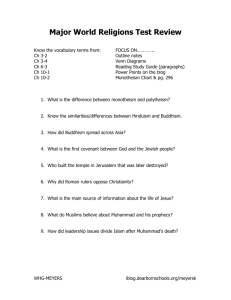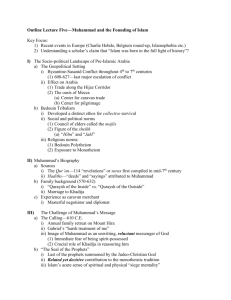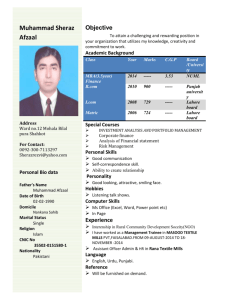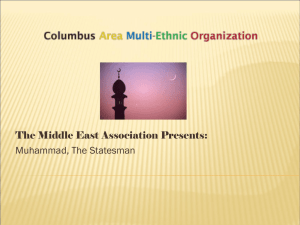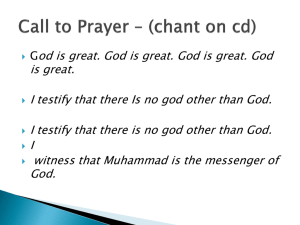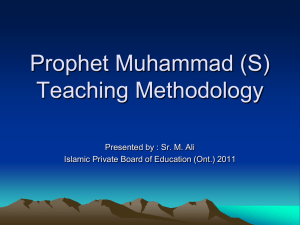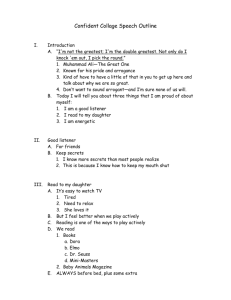Muhammad - WordPress.com
advertisement
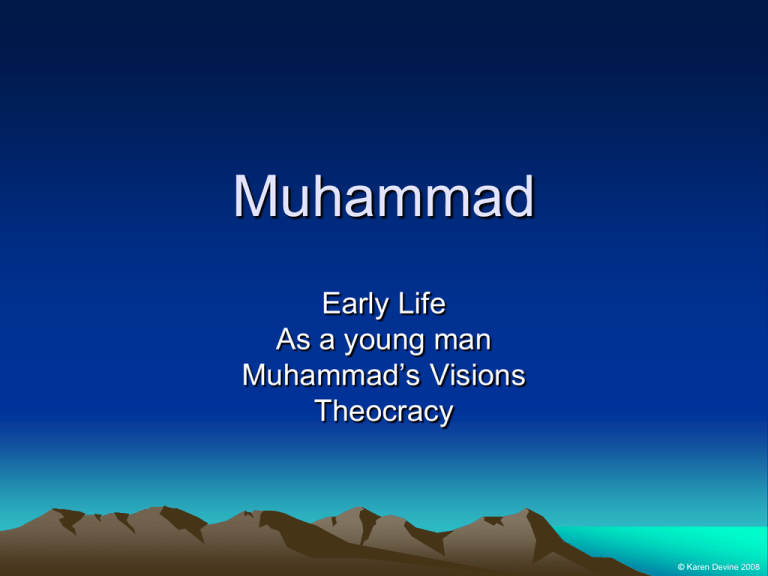
Muhammad Early Life As a young man Muhammad’s Visions Theocracy © Karen Devine 2008 Muhammad’s Early Life • Muhammad was born into the Quraysh tribe around 570 CE. • The Quraysh tribe was responsible for the upkeep of the ancient shrine in Makka (Mecca). • He was orphaned at an early age. • His father Abdullah died six months before he was born. • After his birth he was sent to wet nurses in the hills outside the city. • His mother Amira died before he was 6. • His guardian grandfather died when he was 8. • He was then cared for by his uncle Abu Talib, the leader of the Hashim clan of the Quraysh tribe. Muhammad as a young man. • Muhammad became familiar with the caravan trade and the business of being a merchant. • As a merchant, he met and married Khadijah, a widowed entrepreneur. She was 40 and he was 25. • Together they had 2 or 3 sons and 4 daughters. • All the sons died in childhood and only Fatima survived Muhammad. • Fatima gave Muhammad 2 grandsons: Hasam and Husayn. • Muhammad had more wives after the death of Khadijah. • Muhammad is said to have become disturbed by the changes to Makkan society as it moved in transition from a semi-rural to a commercial society. Muhammad’s Visions • Muhammad decided to meditate upon these changes in a cave on Mt Hira. • It was here that Muhammad’s first revelation occurred when he was 40 years old in 610 CE. • He was visited by the Angel Gabriel. • The first to believe his revelations were Khadijah, his cousin Ali and an older man, Abu Bakr. • The Angel Gabriel put “words on his lips for proclamation” and hence the Qur’an or recitation is first preached. The Themes to Muhammad’s Teaching • • a) b) c) d) Muhammad continued to receive divine revelations over the next 22 years and these messages become the Qur’an. There are four themes to Muhammad’s teachings: the coming of judgement day the unity of God denouncing dishonest practices of merchants denouncing the abandonment of widows and orphans. Muhammad and Controversy Muhammad’s messages were controversial due to: a) his attacks on polytheism b) his attacks on the attitudes that existed in the Makkan society. c) His support of the poor which meant that the rich had to pay more tax. Muhammad was a threat to the rulers of Makka who relied on the pilgrimage to the Ka’ba. The Night Journey In 620 CE Muhammad is invited to Madina to serve as a mediator in a tribal dispute. This migration was known as the Hijira. It was on the journey to Madina, known as the “Night Journey”, that the Angel Gabriel took Muhammad to Jerusalem to the site now known as the “Dome of the Rock”. From there Muhammad was taken to heaven, past all the prophets who preceded him, to the presence of God. Beginnings of a Theocracy Muhammad moves to Madina in 622 CE and this was the beginning of true Islam. Muhammad developed from preacher to political leader. Hence, Madina became a theocracy with Allah as its ruler and Muhammad as the interpreter of God’s will. Muhammad Prohibits • • • • • Idol worship Sexual immorality Drunkenness Gambling Disadvantageous marriage and inheritance laws. Muhammad and Battles In 624 CE at the Battle of Badr, Muhammad engaged in a blockade of caravans from Makka. Here a small band of Muslims defeated a large army. Muhammad’s followers saw this as evidence that angels were fighting on the side of Muslims. There were 3 more successful battles fought by Muhammad. Eventually Muhammad turned both Makka and Madina into cities of God. Muhammad died after a short illness in 632 CE. Muhammad: A Model for Muslim Life • • • a) b) c) d) e) f) g) Muhammad had a strong character and personality. The practices of Muhammad become the guiding source of Islamic law. (Sunna) Muhammad was a: Prophet of God Religious leader Political leader Ruler Military commander Chief judge Law giver. Activity Time • Read pages 103107 • Complete ALL activity questions on page 107.
